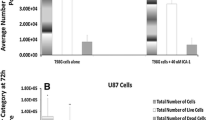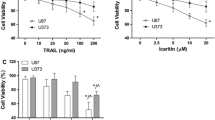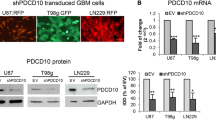Abstract
Tumor necrosis factor-related apoptosis-inducing ligand (TRAIL) has potent antitumor effects in glioma cell lines but has shown little clinical benefit for patients. We investigated whether the widely used chemotherapeutic agent temozolomide (TMZ) can sensitize glioma stem-like cells (GSCs) from human glioblastoma multiforme (GBM) to TRAIL-induced apoptosis. GSCs were isolated from GBM, and stem cell properties were confirmed by immunocytochemistry and in vivo tumorigenicity. Primary GSCs (PGCs) were produced by serum treatment of GBM-derived cells. Changes in expression levels of various TRAIL-related signaling factors before and after TRAIL or TRAIL + TMZ treatment were measured by Western blotting. Overexpression vectors and siRNAs were used to investigate mechanism of TRAIL sensitivity. GSCs showed greater resistance to TRAIL-induced apoptosis than PGCs and had lower basal caspase activity. Caspase knockdown in PGCs reduced TRAIL sensitivity. Expression levels of c-Fas-associated death domain-like interleukin 1-converting enzyme-like inhibitory protein long and short isoforms (c-FLIPL and c-FLIPS) were significantly higher in GSCs than PGCs, and siRNA-mediated c-FLIP knockdown in GSCs enhanced TRAIL-induced apoptosis. TMZ enhanced TRAIL-induced apoptosis in GSCs and downregulated c-FLIP expression. Add of TMZ also upregulated the expression of the E3 ubiquitin ligase casitas B-lineage lymphoma (c-Cbl). Moreover, overexpression of c-Cbl alone reduced c-FLIP expression, and c-Cbl knockdown both enhanced c-FLIP expression and reduced the potentiating effect of TMZ on TRAIL-induced apoptosis. The result indicated that TMZ may overcome TRAIL resistance in GSCs by suppressing c-FLIP expression through c-Cbl-mediated ubiquitination and degradation.





Similar content being viewed by others
References
Clarke J, Butowski N, Chang S. Recent advances in therapy for glioblastoma. Arch Neurol. 2010;67(3):279–83. doi:10.1001/archneurol.2010.5.
Lo Cicero A, Schiera G, Proia P, Saladino P, Savettieri G, Di Liegro CM, et al. Oligodendroglioma cells shed microvesicles which contain TRAIL as well as molecular chaperones and induce cell death in astrocytes. Int J Oncol. 2011;39(6):1353–7. doi:10.3892/ijo.2011.1160.
Syed V, Mukherjee K, Godoy-Tundidor S, Ho SM. Progesterone induces apoptosis in TRAIL-resistant ovarian cancer cells by circumventing c-FLIPL overexpression. J Cell Biochem. 2007;102(2):442–52.
Sciuscio D, Diserens AC, van Dommelen K, Martinet D, Jones G, Janzer RC, et al. Extent and patterns of MGMT promoter methylation in glioblastoma- and respective glioblastoma-derived spheres. Clin Cancer Res. 2011;17(2):255–66. doi:10.1158/1078-0432.CCR-10-1931.
MacFarlane M, Harper N, Snowden RT, Dyer MJ, Barnett GA, Pringle JH, et al. Mechanisms of resistance to TRAIL-induced apoptosis in primary B cell chronic lymphocytic leukaemia. Oncogene. 2002;21(44):6809–18.
Kundu M, Pathak SK, Kumawat K, Basu S, Chatterjee G, Pathak S, et al. A TNF- and c-Cbl-dependent FLIP(S)-degradation pathway and its function in Mycobacterium tuberculosis-induced macrophage apoptosis. Nat Immunol. 2009;10(8):918–26. doi:10.1038/ni.1754.
Hicke L, Dunn R. Regulation of membrane protein transport by ubiquitin and ubiquitin-binding proteins. Annu Rev Cell Dev Biol. 2003;19:141–72.
Ivanov VN, Hei TK. A role for TRAIL/TRAIL-R2 in radiation-induced apoptosis and radiation-induced bystander response of human neural stem cells. Apoptosis. 2014;19(3):399–413. doi:10.1007/s10495-013-0925-4.
Morizot A, Mérino D, Lalaoui N, Jacquemin G, Granci V, Iessi E, et al. Chemotherapy overcomes TRAIL-R4-mediated TRAIL resistance at the DISC level. Cell Death Differ. 2011;18(4):700–11. doi:10.1038/cdd.2010.144.
Qiu B, Zhang D, Wang C, Tao J, Tie X, Qiao Y, et al. IL-10 and TGF-b2 are overexpressed in tumor spheres cultured from human gliomas. Mol Biol Rep. 2011;38(5):3585–91. doi:10.1007/s11033-010-0469-4.
Crowder RN, El-Deiry WS. Caspase-8 regulation of TRAIL-mediated cell death. Exp Oncol. 2012;34(3):160–4.
Hao C, Beguinot F, Condorelli G, Trencia A, Van Meir EG, Yong VW, et al. Induction and intracellular regulation of tumor necrosis factor-related apoptosis-inducing ligand (TRAIL) mediated apotosis in human malignant glioma cells. Cancer Res. 2001;61(3):1162–70.
Bellail AC, Tse MC, Song JH, Phuphanich S, Olson JJ, Sun SY, et al. DR5-mediated DISC controls caspase-8 cleavage and initiation of apoptosis in human glioblastomas. J Cell Mol Med. 2010;14(6A):1303–17. doi:10.1111/j.1582-4934.2009.00777.x.
Singh SK, Hawkins C, Clarke ID, Squire JA, Bayani J, Hide T, et al. Identification of human brain tumour initiating cells. Nature. 2004;432(7015):396–401.
Yuan X, Curtin J, Xiong Y, Liu G, Waschsmann-Hogiu S, Farkas DL, et al. Isolation of cancer stem cells from adult glioblastoma multiforme. Oncogene. 2004;23(58):9392–400.
Ricci-Vitiani L, Lombardi DG, Pilozzi E, Biffoni M, Todaro M, Peschle C, et al. Identification and expansion of human colon-cancer-initiating cells. Nature. 2007;445(7123):111–5.
O'Brien CA, Pollett A, Gallinger S, Dick JE. A human colon cancer cell capable of initiating tumour growth in immunodeficient mice. Nature. 2007;445(7123):106–10.
Karnoub AE, Dash AB, Vo AP, Sullivan A, Brooks MW, Bell GW, et al. Mesenchymal stem cells within tumour stroma promote breast cancer metastasis. Nature. 2007;449(7162):557–63.
Liao MJ, Zhang CC, Zhou B, Zimonjic DB, Mani SA, Kaba M, et al. Enrichment of a population of mammary gland cells that form mammospheres and have in vivo repopulating activity. Cancer Res. 2007;67(17):8131–8.
Bellail AC, Qi L, Mulligan P, Chhabra V, Hao C. TRAIL agonists on clinical trials for cancer therapy: the promises and the challenges. Rev Recent Clin Trials. 2009;4(1):34–41.
Ashkenazi A, Pai RC, Fong S, Leung S, Lawrence DA, Marsters SA, et al. Safety and antitumor activity of recombinant soluble Apo2 ligand. J Clin Invest. 1999;104(2):155–62.
Roth W, Isenmann S, Naumann U, Kügler S, Bähr M, Dichgans J, et al. Locoregional Apo2L/TRAIL eradicates intracranial human malignant glioma xenografts in athymic mice in the absence of neurotoxicity. Biochem Biophys Res Commun. 1999;265(2):479–83.
Singh SK, Clarke ID, Terasaki M, Bonn VE, Hawkins C, Squire J, et al. Identification of a cancer stem cell in human brain tumors. Cancer Res. 2003;63(18):5821–8.
Huang S, Yang ZJ, Yu C, Sinicrope FA. Inhibition of mTOR kinase by AZD8055 can antagonize chemotherapy-induced cell death through autophagy induction and down-regulation of p62/sequestosome 1. J Biol Chem. 2011;286(46):40002–12. doi:10.1074/jbc.M111.297432.
Lee J, Kotliarova S, Kotliarov Y, Li A, Su Q, Donin NM, et al. Tumor stem cells derived from glioblastomas cultured in bFGF and EGF more closely mirror the phenotype and genotype of primary tumors than do serum-cultured cell lines. Cancer Cell. 2006;9(5):391–403.
Johnstone RW, Frew AJ, Smyth MJ. The TRAIL apoptotic pathway in cancer onset, progression and therapy. Nat Rev Cancer. 2008;8(10):782–98. doi:10.1038/nrc2465.
Xiao C, Yang BF, Asadi N, Beguinot F, Hao C. Tumor necrosis factor-related apoptosis-inducing ligand-induced death-inducing signaling complex and its modulation by c-FLIP and PED/PEA-15 in glioma cells. J Biol Chem. 2002;277(28):25020–5.
Niemoeller OM, Belka C. Radiotherapy and TRAIL for cancer therapy. Cancer Lett. 2013;332(2):184–93. doi:10.1016/j.canlet.2011.07.003.
Kim K, Fisher MJ, Xu SQ, el-Deiry WS. Molecular determinants of response to TRAIL in killing of normal and cancer cells. Clin Cancer Res. 2000;6(2):335–46.
Fiveash JB, Gillespie GY, Oliver PG, Zhou T, Belenky ML. Enhancement of glioma radiotherapy and chemotherapy response with targeted antibody therapy against death receptor 5. Int J Radiat Oncol Biol Phys. 2008;71(2):507–16. doi:10.1016/j.ijrobp.2008.02.005.
Saito R, Bringas JR, Panner A, Tamas M, Pieper RO, Berger MS, et al. Convection-enhanced delivery of tumor necrosis factor-related apoptosis-inducing ligand with systemic administration of temozolomide prolongs survival in an intracranial glioblastoma xenograft model. Cancer Res. 2004;64(19):6858–62.
Hingtgen S, Ren X, Terwilliger E, Classon M, Weissleder R, Shah K. Targeting multiple pathways in gliomas with stem cell and viral delivered S-TRAIL and temozolomide. Mol Cancer Ther. 2008;7(11):3575–85. doi:10.1158/1535-7163.
Uzzaman M, Keller G, Germano IM. Enhanced proapoptotic effects of tumor necrosis factor-related apoptosis-inducing ligand on temozolomide-resistant glioma cells. J Neurosurg. 2007;106(4):646–51.
Kim SM, Woo JS, Jeong CH, Ryu CH, Jang JD, Jeun SS. Potential application of temozolomide in mesenchymal stem cell-based TRAIL gene therapy against malignant glioma. Stem Cells Transl Med. 2014;3(2):172–82. doi:10.5966/sctm.2013-0132.
Gratas C, Séry Q, Rabé M, Oliver L, Vallette FM. Bak and Mcl-1 are essential for temozolomide induced cell death in human glioma. Oncotarget. 2014;5(9):2428–35.
Dai C, Zhang B, Liu X, Ma S, Yang Y, Yao Y, et al. Inhibition of PI3K/AKT/mTOR pathway enhances temozolomide-induced cytotoxicity in pituitary adenoma cell lines in vitro and xenografted pituitary adenoma in female nude mice. Endocrinology. 2013;154(3):1247–59. doi:10.1210/en.2012-1908.
Qi XC, Xie DJ, Yan QF, Wang YR, Zhu YX, Qian C, et al. RIG1 dictates the chemo-sensitivity of temozolomide (TMZ) in U251 glioblastoma cells via down-regulation of EGFR/topoisomerase-2/Bcl-2. Biochem Biophys Res Commun. 2013;437(4):565–72. doi:10.1016/j.bbrc.2013.06.116.
Vaillant F, Merino D, Lee L, Breslin K, Pal B, Ritchie ME, et al. Targeting BCL-2 with the BH3 mimetic ABT-199 in estrogen receptor-positive breast cancer. Cancer Cell. 2013;24(1):120–9. doi:10.1016/j.ccr.2013.06.002.
Xin M, Li R, Xie M, Park D, Owonikoko TK, Sica GL, et al. Small-molecule Bax agonists for cancer therapy. Nat Commun. 2014;5:4935. doi:10.1038/ncomms5935.
You S, Li R, Park D, Xie M, Sica GL, Cao Y, et al. Disruption of STAT3 by niclosamide reverses radioresistance of human lung cancer. Mol Cancer Ther. 2014;13(3):606–16. doi:10.1158/1535-7163.
Acknowledgments
This work was supported by the Chinese National Natural Science Foundation (nos. 81101917 and 81172409) (http://www.nsfc.gov.cn/) SL and by the Liaoning Province Natural Science Foundation (no. 2013021045) (http://www.lninfo.gov.cn/).
Conflicts of interest
None
Author information
Authors and Affiliations
Corresponding author
Electronic supplementary material
Below is the link to the electronic supplementary material.
S1 Fig
Role of c-Fas-associated death domain-like interleukin 1-converting enzyme-like inhibitory protein long isoform (c-FLIPL) in tumor necrosis factor-related apoptosis-inducing ligand (TRAIL)-induced apoptosis in primary glioma cells (PGC-No.1 and PGC-No.2). (PDF 94 kb)
S2 Fig
Immunoblot analysis c-FLIPL and c-FLIPS expression in GSC-No.1 and GSC-No.2 transfected with control or c-Cbl cDNA. (PDF 26 kb)
S3 Fig
A total of 295 samples from the Chinese Glioma Genome Atlas (CGGA) database were analyzed; data included whole genome mRNA expression profiles from microarray analyses and corresponding clinical information. The relationship between c-FLIP mRNA expression and glioma grade (II–IV) is shown. (PDF 30 kb)
Rights and permissions
About this article
Cite this article
Zhitao, J., Long, L., Jia, L. et al. Temozolomide sensitizes stem-like cells of glioma spheres to TRAIL-induced apoptosis via upregulation of casitas B-lineage lymphoma (c-Cbl) protein. Tumor Biol. 36, 9621–9630 (2015). https://doi.org/10.1007/s13277-015-3720-8
Received:
Accepted:
Published:
Issue Date:
DOI: https://doi.org/10.1007/s13277-015-3720-8




